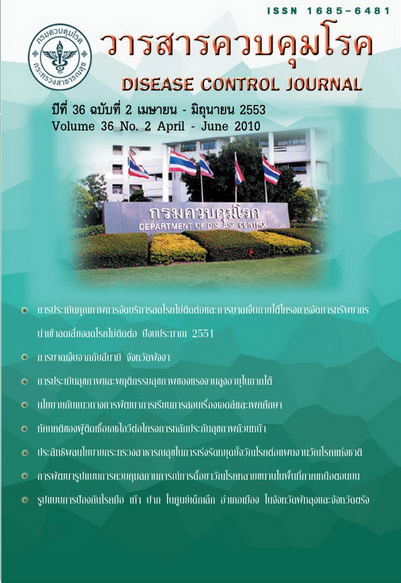Injuries of Tsunami's Victims in Phang-Nga Province
Keywords:
Tsunami, injuries, Phang-NgaAbstract
This descriptive study was aimed to delineate the situations of injuries and deaths from tsunami including characteristics of injuries and wounds, daily expenses and length of hospital admission. Data of patients and expenses for treatment were collected from those patients who were injured due to Tsunami and had the treatment at Takaopa and Phang-Nga hospital during December 26, 2004 to January10, 2005. The results revealed that total of 3,057 cases were sent to the hospitals. About 96.5 percent of them received proper treatment and 3.44 percent were died during ambulation. Both OPD and IPD cases were cured at 87.63 percent and 0.18 percent died while 12.19 percent were referred to center hospital. The age group of 60 years up had the highest case fatality rate. Most of injuries were abrasion wound (43 percent) and slightly injuries (75.26 percent). The average cost of treatment of out patients and in patients were 264.36 and 9,947.50 Baht respectively. The average cost of small wound operation and general operation were 1,798.42 and 16,792.07Baht respectively. The average length of hospital admission in intensive care units and general wards were 4.6 and 4.3 days respectively. We learnt that hospital preparedness plan for massive injury needed to be well planned while the team, equipment, medicine and facilities including transportation should be in readiness.
Downloads
References
2. สมาคมเวชบำบัดวิกฤตแห่งประเทศไทย. Disasters: Roles of Critical care.กรุงเทพมหานคร:บียอนด์ เอ็นเทอร์ไพรซ์; 2548.
3. ทัสสนี นุชประยูร และ เติมศรี ชำนิจารกิจ. สถิติในวิจัยทางการแพทย์. พิมพ์ครั้งที่ 2. กรุงเทพมหานคร: สำนักพิมพ์แห่งจุฬาลงกรณ์มหาวิทยาลัย; 2541.
4. C Watcharong, B Chuckpairong and B Mahaisavariya. Orthopaedic trauma following tsunami: Experience from Phang Nga, Thailand. Journal of Ortopaedic Surgery. 2005; 13: 1-2
5. คู่มือการจัดระบบบริการการแพทย์ฉุกเฉินสำนักงาน ระบบบริการการแพทย์ฉุกเฉิน. สำนักงานปลัด กระทรวงสาธารณสุข. L.T.Press Co.,LTD. กรุงเทพ: 2548.
6.. คู่มือการประสานงานสนับสนุนทรัพยากร เพื่อการช่วยเหลือและส่งต่อผู้ป่วย. กองสาธารณสุขภูมิภาค
7. Huda Q. Addressing Health in emergencies the context of a developing country. Bangladesh Center for Health Emergency Preparedness and Response; 2004.
8. Boroschek R. and Retamales R.Protecting. New Health Facilities from Natural Disaster: Guidelines for the Promotion of Disaster Mitigation. PAHO/WHO Collaborating Center at the University of Chile and on the recommendations adopted at the international meeting "Hospitals in Disasters in Disaster: Handle with Care," EL Salvador; 2003.
9. ธวัช ประสาทฤทธา, รัชตะ ตั้งศิริพัฒน์, ไพโรจน์ วราชิต. The revisit of 2004 tsunami in Thailand characteristics of wounds. International Wound Journal. 2008; 5: 8-9
10. สันต์ หัตถีรัตน์.คู่มือสู้ภัยพิบัติสำหรับ โรงพยาบาล. พิมพ์ครั้งที่ 1.กรุงเทพมหานคร:หมอชาวบ้าน; เมษายน 2552.
Downloads
Published
How to Cite
Issue
Section
License
Articles published in the Disease Control Journal are considered as academic work, research or analysis of the personal opinion of the authors, not the opinion of the Thailand Department of Disease Control or editorial team. The authors must be responsible for their articles.


.png)



